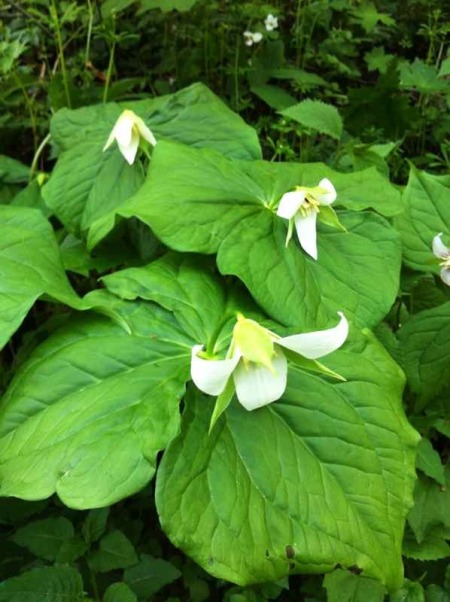This post comes to you in triptych form; bicycle, bicycle botany, and bicycle birding.
Bicycle: Riding Grapevine
The kids and I are spending the week at Grandpa and Grandma's house in the mountains of western North Carolina. They live on Fisher Branch (a branch is a small stream that a healthy Appalachian resident could easily jump over. The key word is healthy. This eliminates 95% of the population of Western North Carolina), which is near the community of Center (a fork in the road), which is near the community of Petersburg (an actual cross road), which is near the town of Mars Hill (a real town), which is about 16 miles north of Asheville, North Carolina. Needless to say, they are up in the hills.
The road that leads from Center to Fisher Branch is Grapevine. Grapevine is a road that is about 7.3 miles long. It runs the length of Grapevine Valley, which is only a few miles long. The rest of Grapevine road goes up and over Walnut Mountain to Big Laurel Road in Big Laurel. Got that? Don't feel bad, I ain't got it either. What's important is that Grapevine road crest Walnut Mountain at approximately 3163' in elevation. When you ride your bike from Fisher Branch to Big Laurel it is a round trip ride of about 14.6 miles with about 2000' of elevation gain (see a map of the route here). It takes about an hour and a half. All in all it is a pretty good workout with some fantastic views. Like this one.

Bicycle Botany: Stinking Willies
On the way up and to the pass on Walnut Mountain the pace is kind of slow. Slow enough that a cyclist can glance over and check out the flowering plants as you go. Coming up on the far side of Walnut Mountain I passed a small stream that was loaded with many different kinds of flowering plants. The most dominant amongst them was a species of Trillium.

This is Trillium erectum. Here is a good example of why the use of the scientific name is a good ideal.
Scientific Name: Trillium erectum (L.)
Common Names: Wake Robin, Red Trillium, Purple Trillium, Stinking Trillium, Birthroot, Beth Root, Stinking Benjamin, Stinking Willie, Birth Wort, Nodding Wake-Robin, Bathroot, Bathwort, Bath Lily, Nosebleed Trillium, Ill-sented Trillium, Indian, Shamrock, Squawroot, Lamb's Quarters, Ground Lily, Wood Lily, Daffy Downlily, Jew's Harp Plant, Milk Ipecac, Pariswort, Rattlesnake Root, Bumblebee Root, Truelove, and last but not least, Three-leafed Nightshage.
The reasons that T. erectum has acquired so many common names are many. One reason is because it is a showy plant that is wide spread in eastern North American so many people (other than plant nerds) take notice of it. It is also highly variable, coming in white, red, purple, pink, and rarely yellow and green, leading people to believe that they were different plants. It was also used for medicinal purposes by early midwives and Native American cultures as something that would induce labor or help control hemorrhaging during childbirth. And as some of those names imply, it also smells to high heaven. Like skunk cabbage it is a plant that uses the smell of rotten meat to attached pollinators like flies and beetles. The common names that caught our attention was "stinking willie." When we pointed this out to William he screamed "Oh no! Another reason for Emily to torture me!" Back in Grandpa Gene's yard there was a deep red one blooming. Same species different flavor!

As I mentioned above it enjoys a wide distribution through eastern North America. In North Carolina is primarily found the western mountains. It Pennsylvania it is found in almost every county except Chester! So, I'm going to enjoy it while I'm here.
Bicycle Birding: The land speed of a Turkey
Coming down Walnut Mountain may sound like an easy thing. However, it is almost as difficult coming down as it is coming up. The reason is for the winding road, with many hairpin turns and blind curves, that is starting to deteriorate with gravel and sand in the most unwanted places. Going up the workout is with your legs. Coming down it is with your forearms because you are applying the breaks where possible without skidding over the side.
Coming down you always want to make sure you stay in your lane because a car coming up would certainly take you out. Today, I round a curve and found something else to worry about. A male (tom) American Turkey jumped in front of me with on a few feet to spare. I was able to slow down enough as to avoid and negative outcome for both the large dark chicken and cyclist alike.
Once the situation was under control the turkey did the oddest thing in that it ran straight down the road about 10 feet in front of me. We rounded a bend and it kept on running. I laughed out loud (lol) at the way it dashed down the road; a view of a turkey that I have never seen. I glanced down at my speedometer and was impressed that this bird that I always thought of as clumsy and somewhat gangly moved along at a steady 16+ mph! After about 100 yards of this we got to one bend and the turkey simply ran off the edge of the road, spread it's wings and flew up into a tree. I chose not to follow suit, made the turn and continued down the mountainside via the road.
Ride lots, stop often,
Russell
 Russell Rogers Posted on
Russell Rogers Posted on  Thursday, April 12, 2012 at 1:21PM
Thursday, April 12, 2012 at 1:21PM 


